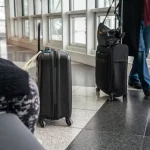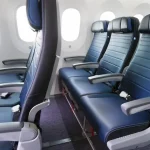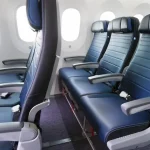What Happened During the Coyote Strike at Chicago O’Hare?
On a brisk morning in April 2025, a United Airlines aircraft preparing for takeoff at Chicago O’Hare International Airport struck an unexpected obstacle , a coyote. The animal had somehow made its way onto one of the airport’s active runways. The flight, destined for Denver, aborted takeoff after the crew reported a significant impact near the landing gear. Airport operations temporarily halted departures on the affected runway.
No injuries were reported, and the aircraft returned safely to the gate. According to a preliminary statement from the FAA, the strike occurred at approximately 6:42 a.m., prompting an immediate runway inspection and wildlife hazard review.
How Common Are Wildlife Strikes at Major U.S. Airports?
Wildlife strikes are a persistent concern for aviation safety in the United States. FAA data recorded over 16,000 wildlife strikes in 2023, with birds accounting for more than 90% of cases. However, mammals,including deer, coyotes, and even domestic animals, constitute a small but high-risk category.
Chicago O’Hare has previously reported over 200 wildlife strikes annually. While most involve avian species, mammal incursions, though rarer, often lead to higher damage costs and safety concerns. Similar mammal strike incidents have occurred at airports in Dallas, Atlanta, and Salt Lake City.
Why Are Coyotes Found Near Runways at O’Hare?
Coyotes are highly adaptable mammals, thriving in both wild and urban environments. The Chicago metropolitan area, including airport property, offers a mix of wooded areas, stormwater management zones, and minimal human traffic, ideal conditions for coyote habitation.
Experts from the USDA’s Wildlife Services division note that airport ecosystems inadvertently attract such predators. Food scraps from airport waste systems, gaps in fencing, and landscape features like tall grass can all lure wildlife. “O’Hare sits at an intersection of human infrastructure and ecological corridors,” says Dr. Lisa Cargill, a wildlife biologist with over 20 years of experience. “The presence of coyotes is not surprising, but their access to critical zones like runways is a red flag.”
What Are the Safety Protocols for Wildlife Hazards at Airports?
Airports are mandated by the FAA to implement Wildlife Hazard Management Plans (WHMPs), especially if they experience recurrent wildlife strikes. These protocols include:
- Daily runway and perimeter inspections
- Installation of wildlife fencing and deterrents
- Habitat management to reduce attractants
- Coordination with federal wildlife agencies
Chicago O’Hare operates under an extensive WHMP, developed in coordination with the FAA and USDA. This includes motion-activated cameras, radar-based detection systems, and contracted wildlife biologists. Despite these measures, the coyote’s breach of the runway perimeter indicates a potential lapse or circumstantial failure in the system.
How Did United Airlines Respond to the Incident?
United Airlines swiftly issued a public statement confirming the incident and affirming its commitment to safety. The aircraft underwent immediate mechanical inspection, and engineers cleared it for service later the same day. Passengers were accommodated on alternate flights with minimal delays.
Spokesperson Carla Benson stated, “Safety is our top priority. Our crew followed procedures precisely, and we’re cooperating with airport officials to understand how this occurred.”
What Are the Legal and Insurance Implications of a Wildlife Strike?
Wildlife strikes are typically classified as “acts of nature,” shielding airlines from direct liability in most cases. However, airport authorities may face scrutiny if investigations reveal negligence in perimeter control or wildlife management.
Aircraft damage due to animal strikes falls under comprehensive insurance policies carried by both airlines and airports. Aviation attorney Robert Lanning notes, “If the airport failed in its duty to maintain a secure runway environment, liability may shift toward the operator. The legal threshold lies in whether the hazard was reasonably foreseeable and preventable.”
Could the Incident Have Been Prevented?
While prevention systems are in place, no mitigation strategy is foolproof. Experts agree that absolute exclusion of all wildlife from large airport environments is virtually impossible. However, Dr. Henry Morales, a senior aviation risk consultant, believes improvements are still possible: “New technologies like thermal imaging, real-time perimeter AI monitoring, and predictive wildlife modeling could reduce these incidents further.”
O’Hare has previously invested in a $5 million wildlife deterrent system. The effectiveness of these investments will now likely undergo audit.
How Has the Public Reacted to the Coyote Strike?
Public reaction ranged from surprise to concern. Passengers on the affected flight shared mixed responses on social media. Some expressed shock that a wild animal could access a secured runway at one of the busiest airports in the world.
Airport management acknowledged the concerns in a press release, reinforcing their dedication to safety and transparency. Aviation forums and local Chicago news outlets also picked up the story, sparking wider debate about urban wildlife management near critical infrastructure.
What Are Airports Doing to Prevent Future Coyote Strikes?
Airports across the U.S. are adopting more sophisticated wildlife deterrence methods. These include:
- Wildlife-detecting radar and infrared systems
- Electrified and buried fencing to deter burrowing
- Predictive AI models that map animal movement patterns
- Auditory and visual deterrents (e.g., pyrotechnics, falconry)
O’Hare has initiated a review of its Wildlife Hazard Management Plan and will likely implement reinforcements to its perimeter controls. Airport authorities are also expected to conduct joint drills with USDA and FAA partners in response to the strike.
Related Incidents Involving United Airlines and Wildlife
United Airlines has faced wildlife-related incidents in the past, though few have involved terrestrial mammals. In 2020, a bird strike forced a United flight out of Newark to return shortly after takeoff. In 2017, a similar incident occurred in Denver, damaging an engine blade.
Post-incident protocols often include crew retraining, adjustments to routing procedures, and updates to hazard communication systems. The coyote strike may lead to revised checklists for low-visibility runway scans or additional taxiway surveillance.
FAQs About Wildlife Strikes in Aviation
What is the most common animal involved in aircraft strikes?
Birds are the most common, accounting for over 90% of all wildlife strikes in U.S. airspace.
Can a coyote disable a commercial aircraft?
Yes, especially if the strike affects landing gear, engines, or control surfaces. Impact location determines the extent of damage.
Do airlines cancel flights after an animal strike?
Flights may be delayed or canceled depending on aircraft inspection results, crew availability, and operational risk assessment.





